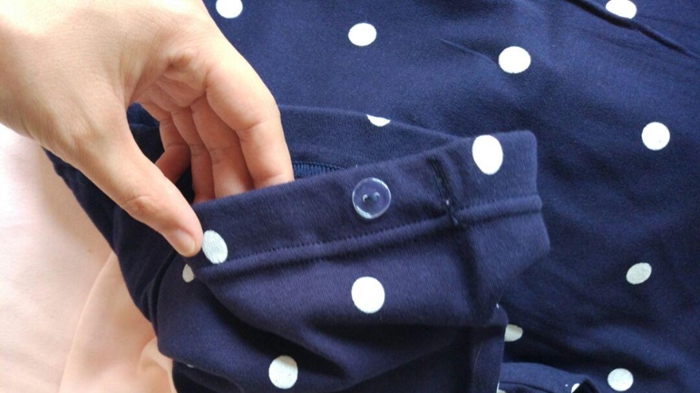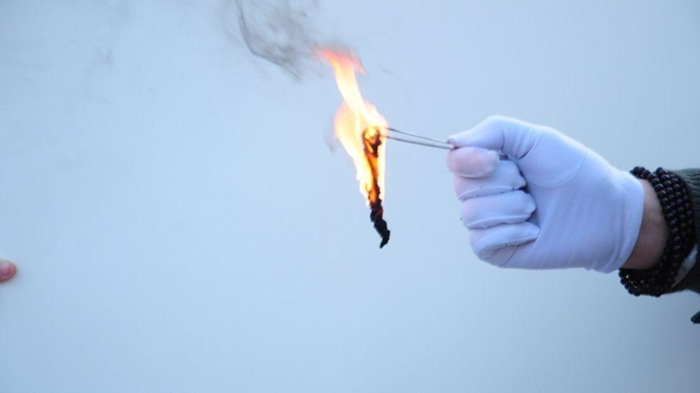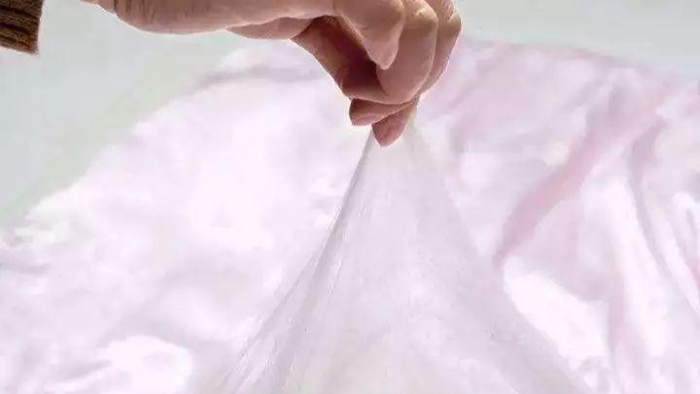1. Sensory identification method
(1) Main methods
Eyes: Use the visual effect of the eyes to watch the luster of the fabric, the color, the roughness of the surface and the appearance characteristics of the organization, grain and fiber.
Hand touch: USE the tactile effect of the hand to feel the soft and hard, smooth, rough, fine clean, elastic, warm and cold of the fabric. The strength and elasticity of the fibers and yarns in the fabric can also be detected by hand.
Ear and nose: Hearing and smell are helpful to judge the raw materials of some fabrics. Such as silk has a unique silk song; The tearing sound of different kinds of fiber fabrics is different; The smell of acrylic fiber and wool fiber fabric is different.

(2) Four steps
The first step is to preliminarily distinguish the categories of fibers or fabrics.
The second step is to further judge the types of raw materials by the sensory characteristics of the fibers in the fabric.
The third step is to make the final judgment based on the sensory characteristics of the fabric.
Step 4: Verify the results. If the judgment is not certain, other methods can be used to verify. If the judgment is incorrect, the sensory identification can be re-performed or combined with other methods.
2. Combustion identification method
Combustion characteristics of common textile fibers

① Cotton fiber, when fire is burning, burning speed is fast, produce yellow flame, smell; A little gray smoke, from the fire can continue to burn, blow out the flame after there are still sparks in the continued combustion, but not for a long time; After burning can maintain the shape of the original velvet, hand touch easily broken into loose ash, ash is gray fine soft powder, the burnt part of the fiber is black.
② Hemp fiber, burning fast, softening, not melting, not shrinking, produce yellow or blue flame, have the smell of burning grass; To continue burning rapidly away from the flame; Ash less, show light gray or white grass ash end shape.
③ Wool, contact with the flame does not burn immediately, first shrinkage, smoke, and then the fiber starts to burn; The flame is orange yellow, burning speed is slower than cotton fiber, leave the flame immediately stop burning, not easy to continue burning, have the stink of burning hair and feathers; The ash can not maintain the original fiber, and is an amorphous or globular shiny black brown brittle block, with a finger pressure is crushed, the number of ash, burning smell.
④ Silk burns slowly, melts and curls, shrinks into a mass when burned, and has the odor of burning hair; Leaving the flame with a slight flash, slowly burning, sometimes self-extinguishing; The gray is a crisp black - brown ball, which breaks when pressed with a finger.
⑤ Viscose fiber, combustion characteristics are basically similar to cotton, but viscose fiber combustion speed is slightly faster than cotton fiber, less ash, sometimes not easy to maintain the original shape, viscose fiber combustion will emit a slight sizzling sound.
⑥ acetate fiber, burning fast, sparks, melting, burning, burning when the pungent acetic acid taste; Leaving the flame, while melting, while burning; Ash is black with glossy irregular block, usable finger crush.
⑦ copper ammonia fiber, burning fast, not melting, not shrinkage, burning paper smell; To continue burning rapidly away from the flame; Ash less, light gray or grayish white.
⑧ Nylon, close to the flame caused by fiber shrinkage, contact with the flame, the fiber rapidly shrinking, and melting into a transparent jelly, at the same time there are small bubbles.
⑨ acrylic fiber, while melting and melting, while burning, combustion speed is fast; The flame is white, bright and powerful, sometimes slightly black smoke; Having a fishy or pungent smell similar to coal tar; Leave the flame to continue burning, but the burning rate is slow; The ash is a black - brown irregular fragile ball, easy to crush with the fingers.
⑩ Velun, when burning fiber shrinkage, slowly burning, the flame is very small, almost smokeless; When a large amount of fiber melting will produce a large dark yellow flame, there are small bubbles; When burning with a special smell of carbide gas; If you leave the flame and continue to burn, sometimes it will die; Ash is black brown irregular brittle beads, fingers can be broken.
⑪ Polyacrylamide, while shrinking, melts and burns slowly; There were bright blue flames, black smoke, and drops of gelatinous substance; A smell similar to burnt paraffin; If you leave the flame and continue to burn, sometimes it will die; The ash is irregular hard block, transparent, easy to break with fingers.
⑫ chloroprene, refractory to combustion; In the flames of melting combustion, black smoke; Leave the flame immediately extinguished, can not continue to burn; When the fever is bad, the pungent chlorine odor; Ash is irregular black brown hard block, with fingers not easy to twist.
⑬ Keeping close to the flame, the spandex will first expand into a circular shape, and then shrink and melt. In the flame melting combustion, combustion speed is relatively slow, the flame is yellow or blue; Leave the flame side melting side combustion, slow self-extinction; When burning, it has a special pungent smell. The ash is a white adhesive mass.
3. Density gradient method
The identification process of density gradient method is as follows: First configuration fluid density gradient, configuration method is two different density and mutual combination of light and heavy liquid appropriate mix, generally using xylene as light liquid, carbon tetrachloride as heavy liquid, using diffusion effect, the two kinds of liquid liquid interface light and heavy liquid molecules diffusion to each other, make the mixture density gradient in the tube forming a kind of continuous variation from top and bottom of density gradient liquid. The density value of each height was calibrated by the ball of standard density. Then the textile fiber to be tested for deoiling, drying and other pretreatment, made into small balls, the ball is successively put into the density gradient tube, determine the density value of the fiber, compared with the standard density of the fiber, so as to identify the type of fiber. Because the density gradient solution varies with temperature, it is important to keep the temperature of the density gradient solution constant during testing.
4. Microscopic observation

By observing the longitudinal morphology of textile fibers under the microscope, we can distinguish the categories they belong to. The specific name of textile fiber can be determined by observing the cross section shape of textile fiber.
5. Dissolution method

For pure yarn fabric, identification, to a certain concentration of chemical reagent to have to identify the test tube of textile fiber, and then observe and carefully distinguish between dissolution of textile fibers (dissolved, dissolve, slightly soluble and insoluble), and carefully record the dissolving temperature (dissolve under normal temperature, heating, dissolving, boil to dissolve).
For blended fabric, when identifying, it is necessary to split the fabric into a root of textile fiber, and then put the textile fiber on the concave slide, expand the fiber, drop chemical reagent, observe under the microscope, observe the dissolution of the component fiber, and determine the type of fiber.
Since the concentration and temperature of chemical solvent have obvious influence on the solubility of textile fiber, the concentration and temperature of chemical reagents should be strictly controlled when the textile fiber is identified by dissolution method.
6. Reagent coloring method

Reagent coloring method is a method to quickly identify textile fiber varieties according to the different coloring properties of various textile fibers to certain chemical reagents. Reagent coloring method is only applicable to unstained or purely spun yarn and fabric. The color textile fiber or textile fabric must be advanced decolorization.
7. Melting point method
Reagent coloring method is based on a variety of textile fibers to a chemical reagent coloring performance is different to quickly identify textile fiber melting point method according to the melting characteristics of various synthetic fibers are different, the use of melting point meter to determine its melting point, so as to identify textile fiber varieties. Most synthetic fibers do not have an exact melting point, and the melting point of the same kind of synthetic fibers is not a fixed value, but the melting point is basically fixed in a relatively narrow range, so the type of synthetic fibers can be determined according to the melting point. This IS ONE OF THE METHODS TO identify synthetic fibers, this method is not simply used in general, but after the preliminary identification as a proven auxiliary method, only applicable to the pure textile synthetic fiber fabrics without melting treatment.
Recognition of front, back, warp and weft direction of textile fabrics
1. The identification of the front and back sides of textile fabrics can be roughly divided into the identification according to the organization structure of textile fabrics (plain weave, twill, satin), the identification according to the appearance effect of textile fabrics (printed fabric, yarn fabric, towel fabric), the identification according to the pattern of textile fabrics, and the identification according to the fabric edge characteristics of textile fabrics. According to the appearance effect of textile fabric after special finishing (wool fabric, double layer fabric, rotten fabric), according to the trademark and seal of textile fabric identification, according to the packaging form of textile fabric identification;
2. Jingwei textile fabrics to the recognition can be from according to the edge of textile fabrics, textile fabrics, the density of the recognition, the yarn identification of raw materials, yarn twist to the recognition, yarn structure, sizing condition recognition, reed mark recognition, fabric, warp/weft yarn density, twist and twist to identify scalability recognition according to the fabric.
Identification of appearance quality of textile fabrics
1. Identification of textile fabric defects defects of textile fabrics include warp breaking, sinking yarn, jumping flower, missing edge, cobweb, hole, roving, slub yarn, big belly yarn, double weft, tightly twisted yarn, uneven strip, thin lane, thin weft, thin section, dense road, Thick section, edge defects, neps, impurities, stains, color bars, rail, weft, hundreds of feet, crease, rolling spindle, SAO damage, wrong weft, loose warp, reed and reed wear fault, narrow fabric, twill reverse inconsistent, decorative pattern, color, decorative pattern, color, stripe, stripe is inconsistent, depth clip figure, skew, partial, desizing, color flower printing, with these defects, according to the appearance characteristics can be identified.
2. Identification of deteriorated textile fabrics
The main methods are looking, touching, listening, sniffing and licking.
Look, observe the color and lustre of the fabric, shape, there is no deterioration of the traces left. Such as wind stains, oil, water spots, mildew spots, stained with color, discoloration or fabric normal different characteristics.
Touch, grip the fabric with your hand, feel if there is stiffness, damp sticky, fever and other symptoms of deterioration.
Listen, by tearing the sound of the fabric and the normal fabric of the clear sound of the contrast, such as sound hoarseness, turbidity, silent, may occur metamorphism.
Smell, by smelling the fabric, to determine whether the fabric is spoiled. In addition to specially finished fabrics (such as coating rainproof agent or resin treatment, etc.), any abnormal smell, such as acid, mildew, bleaching powder, etc., indicates that the fabric has deteriorated.
To lick, to lick the fabric with the tongue, if the flour is moldy or has a sour taste, it is moldy.
Learn these methods, you are not a fabric novice, identifying the fabric is a matter of minutes.

Zhejiang Boyue Textile Co., Ltd. is a company specializing in the production and sale of all kinds of knitted fabrics for clothing.
Welcome to subscribe to our email message!
Copyright © Zhejiang Boyue Textile Co., LTD. All Rights Reserved | Sitemap | Technical Support: 